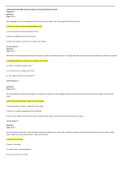Samenvatting
Samenvatting Principles of Cognitive Neuroscience hoofdstuk 8 t/m 15 ()
- Vak
- Instelling
- Boek
Een samenvatting van de hoofdstukken 8 t/m 15 van het boek Principles of Cognitive Neuroscience. Deze hoofdstukken heb je nodig voor het tweede deeltentamen van het vak Cognitive Neuroscience aan de Universiteit van Utrecht. Veel succes met leren!
[Meer zien]













